Affected by continuous strong rainfalls in later June, Jiuzhaigou
National Park will be closed from 1st July, 2018 to protect tourists
from the possible landslides and debris flows. The National Park hasn't
informed the exact date when it will reopen. We will keep the latest
news updated on our website. Please contact your travel consultant to
adjust your itinerary accordingly.
Jiuzhaigou Valley, located in the north of Sichuan province, China,
is the world heritage site and national park, also called Jiuzhaigou
Natural Reserve. Getting its name from having Nine Tibetan Fortified
Villages, Jiuzhaigou features the awesome sceneries of multi-level
waterfalls, crystal waters and colorful lakes. Travel in different
season, the water in Jiuzhaigou will present various color patterns of
white, blue, green, turquoise and emerald.
Jiuzhaigou Landscape & Geology
Being the transition zone between Tibet Plateau and Sichuan
Basin, the Jiuzhaigou’s landscape is made up of high-altitude karsts and
carbonate rock strata, which caused by earth's crust lifting, glacial
and hydrological activity. Due to the glacial effect, Jiuzhaigou has the
peculiar waterscape of calcified lakes, waterfalls and travertine beach
lands. Featuring in colorful lakes with high concentration of calcium
carbonate, and water in Jiuzhaigou is so clear that the bottom can be
seen at high depths.
Jiuzhaigou Scenic Areas
Jiuzhaigou is arranged in the Y shape with a total length of
over 50 km. By consisting of three main valleys, called Shuzheng Valley
(main gully), Zechawa Valley(left gully), Rize Valley (right gully) and
the magnificent Nuorilang Waterfall, Jiuzhaigou has over 100 lakes and
waterfalls. Here are the main scenic areas with featured spots to visit:
Shuzheng Valley
The main valley of Jiuzhaigou, Shuzheng Valley is about 13.8 km extending from the mouth of the valley to the intersection of Nuorilang. Come all the way in, you’ll find:
Shuzheng Lakes: getting into the gate, you’ll encounter various kinds of small streams, which are called Shuzheng Lakes. Spreading over 5 km, it consists of Sparking Lake, Shuzheng Waterfall, Tiger Lake and about 19 lakes. Go over along the way, you can enjoy the great nature with traditional Tibetan villages.
Rhinoceros Lake: as the second largest lake, Rhinoceros Lake is about 2.2 km long, and 17 meters depth, extending to 200,000 square meters. Visit in Summer, you can view it changing into different green in the different area. There is a saying about its name that a monk riding a rhinoceros was infatuated with the scenery and went to the lake with the rhinoceros. If you are lucky enough, you can see the rhinoceros in the bottom.
Nuorilang Waterfall
Lie in the 2400 meters above sea level, Nuorilang is the junction of the Zechawa, Rize and Shuzheng valleys. As the tourist bus transfer center, it also offers Tibetan restaurants and local village hostels.
Nuorilang Waterfall, as the widest calcified waterfall in China, is about 300 meters wide and 20 meters high. This majestic waterfall can be appreciated in different distance. Tumbling down the side of the mountain in great bursts of foam, you’ll feel a sense of coolness when foaming water splashed on your body; overlooked the in the opposite viewing pavilion, it like a white screen pouring down with a gurgling sound. There is no wonder why it is the symbol of Jiuzhaigou.
Zechawa Valley
About 18 km length, Zechawa Valley is the longest valley. As the south-eastern branch of Jiuzhaigou, it includes the highest altitude Long Lake, Five Color Pond, etc.
Long Lake: surrounded by mountains and trees, Long Lake is the longest and widest lake, located south east of the valley. In the shape of S, the water in Long Lake is melted from snow-clad mountains and never dry up and spill over. With its amazing blue water and green color on the lake, it’s the one of the ideal site to take photos.
Five Color Pond: as the smallest lake in Jiuzhaigou, Five Color Pond riches most colors, also called Jade Lake. Due to the different mineral concentration, the water in different depths create different color spectrum from pale blue through aquamarine to emerald green.
Rize Valley
Located in the south-western of Jiuzhaigou, Rize Valley branch with 18 km long is another classic visit route for its various scenic spots sites, including:
Panda Lake: Features curious color patterns of blue and green, this lake was side the land where Giant Pandas came to drink. Surrounded by white stones with several rings of black floral forms scatter naturally underwater and beside the lake, it seems like a shape of panda. What’s more, it is the only lake where have fishes on the bottom. With enough time, you can also take a look at the multi-stream and multi-level Panda Waterfalls.
Five Flower Lake: as the essence of Jiuzhaigou, Fiver Flower Lake features different colors by the different angles of light refraction. Surrounded by yellow and green trees, this blue lake reflects more mixed colors when you view in different sides. With the clear water, you can even see old woods sink on the bottom.
Pearl Shoal: Known for its stunning views of wide waterfall, caused by water flowing from Pearl Shoals and falling at end of the cliffs. As the name suggested, under the sunlight, the water crashing rocks like a rope of pearl. When coming to the cliff, those pearl drops converge into mighty torrent gushing down to the valley. You could see the waterfalls from different angles to capture different views.
Mirror Lake: like a mirror, the Mirror Lake reflects the surrounding peaks, plants into its quiet lake surface and changes the inverted images more beautiful than themselves. Request highly for the weather and light, the best time to visit Mirror Lake is on sunny day before 9:00 and 17:00 before sun set.
Shuzheng Valley
The main valley of Jiuzhaigou, Shuzheng Valley is about 13.8 km extending from the mouth of the valley to the intersection of Nuorilang. Come all the way in, you’ll find:
Shuzheng Lakes: getting into the gate, you’ll encounter various kinds of small streams, which are called Shuzheng Lakes. Spreading over 5 km, it consists of Sparking Lake, Shuzheng Waterfall, Tiger Lake and about 19 lakes. Go over along the way, you can enjoy the great nature with traditional Tibetan villages.
Rhinoceros Lake: as the second largest lake, Rhinoceros Lake is about 2.2 km long, and 17 meters depth, extending to 200,000 square meters. Visit in Summer, you can view it changing into different green in the different area. There is a saying about its name that a monk riding a rhinoceros was infatuated with the scenery and went to the lake with the rhinoceros. If you are lucky enough, you can see the rhinoceros in the bottom.
Nuorilang Waterfall
Lie in the 2400 meters above sea level, Nuorilang is the junction of the Zechawa, Rize and Shuzheng valleys. As the tourist bus transfer center, it also offers Tibetan restaurants and local village hostels.
Nuorilang Waterfall, as the widest calcified waterfall in China, is about 300 meters wide and 20 meters high. This majestic waterfall can be appreciated in different distance. Tumbling down the side of the mountain in great bursts of foam, you’ll feel a sense of coolness when foaming water splashed on your body; overlooked the in the opposite viewing pavilion, it like a white screen pouring down with a gurgling sound. There is no wonder why it is the symbol of Jiuzhaigou.
Zechawa Valley
About 18 km length, Zechawa Valley is the longest valley. As the south-eastern branch of Jiuzhaigou, it includes the highest altitude Long Lake, Five Color Pond, etc.
Long Lake: surrounded by mountains and trees, Long Lake is the longest and widest lake, located south east of the valley. In the shape of S, the water in Long Lake is melted from snow-clad mountains and never dry up and spill over. With its amazing blue water and green color on the lake, it’s the one of the ideal site to take photos.
Five Color Pond: as the smallest lake in Jiuzhaigou, Five Color Pond riches most colors, also called Jade Lake. Due to the different mineral concentration, the water in different depths create different color spectrum from pale blue through aquamarine to emerald green.
Rize Valley
Located in the south-western of Jiuzhaigou, Rize Valley branch with 18 km long is another classic visit route for its various scenic spots sites, including:
Panda Lake: Features curious color patterns of blue and green, this lake was side the land where Giant Pandas came to drink. Surrounded by white stones with several rings of black floral forms scatter naturally underwater and beside the lake, it seems like a shape of panda. What’s more, it is the only lake where have fishes on the bottom. With enough time, you can also take a look at the multi-stream and multi-level Panda Waterfalls.
Five Flower Lake: as the essence of Jiuzhaigou, Fiver Flower Lake features different colors by the different angles of light refraction. Surrounded by yellow and green trees, this blue lake reflects more mixed colors when you view in different sides. With the clear water, you can even see old woods sink on the bottom.
Pearl Shoal: Known for its stunning views of wide waterfall, caused by water flowing from Pearl Shoals and falling at end of the cliffs. As the name suggested, under the sunlight, the water crashing rocks like a rope of pearl. When coming to the cliff, those pearl drops converge into mighty torrent gushing down to the valley. You could see the waterfalls from different angles to capture different views.
Mirror Lake: like a mirror, the Mirror Lake reflects the surrounding peaks, plants into its quiet lake surface and changes the inverted images more beautiful than themselves. Request highly for the weather and light, the best time to visit Mirror Lake is on sunny day before 9:00 and 17:00 before sun set.
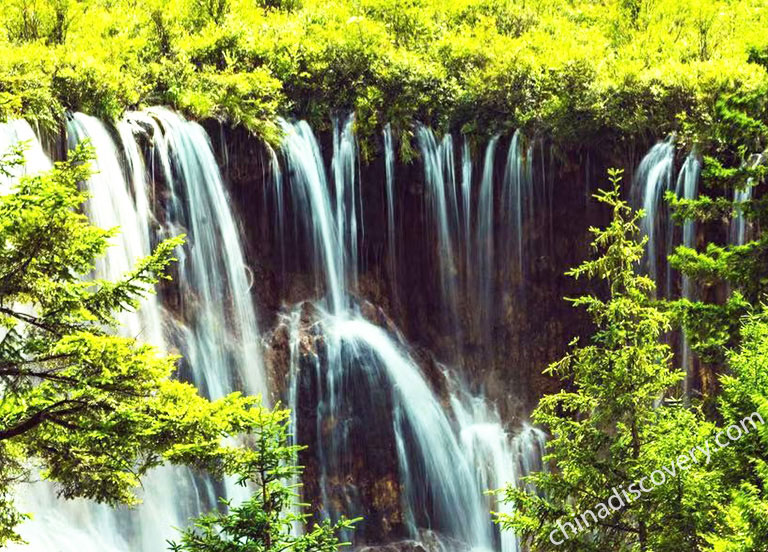
Nuorilang Waterfall
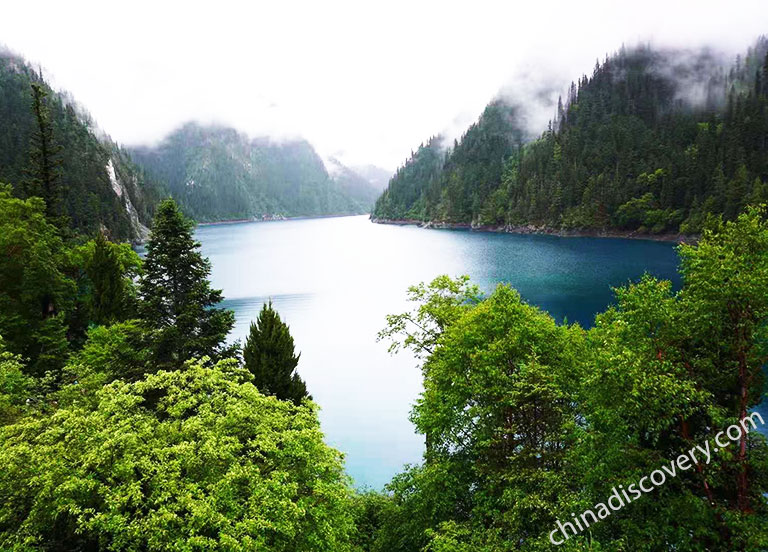
Long Lake
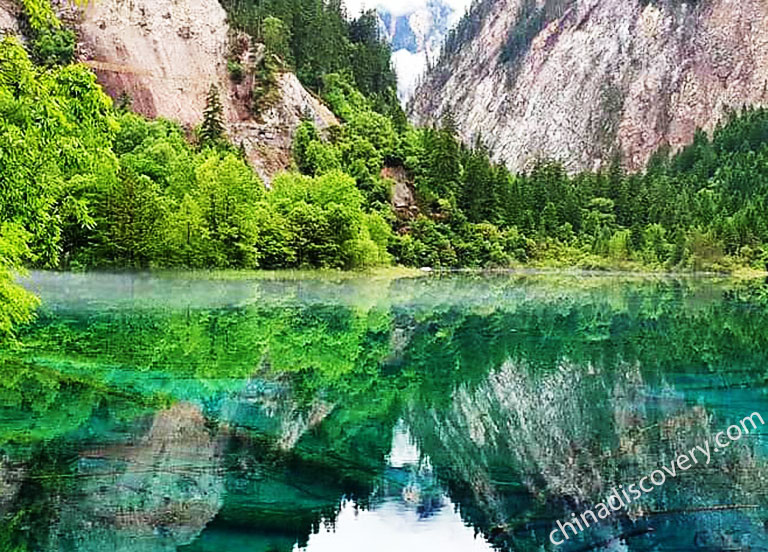
Five Color Pond
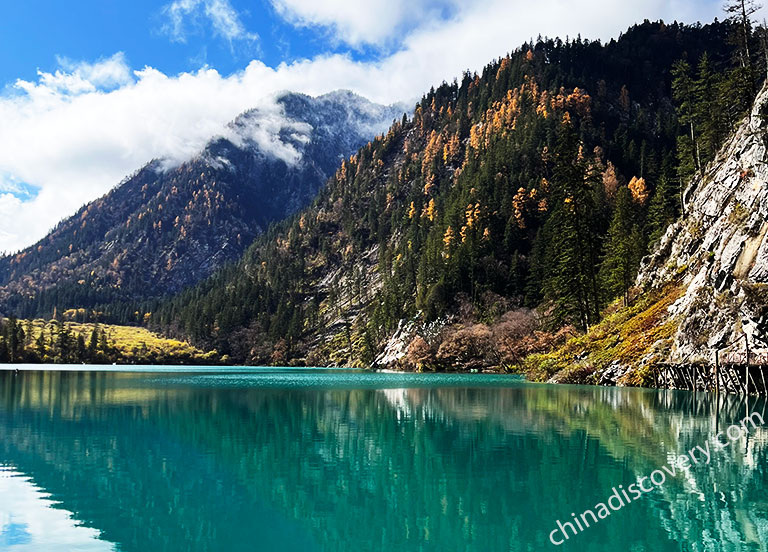
Panda Lake
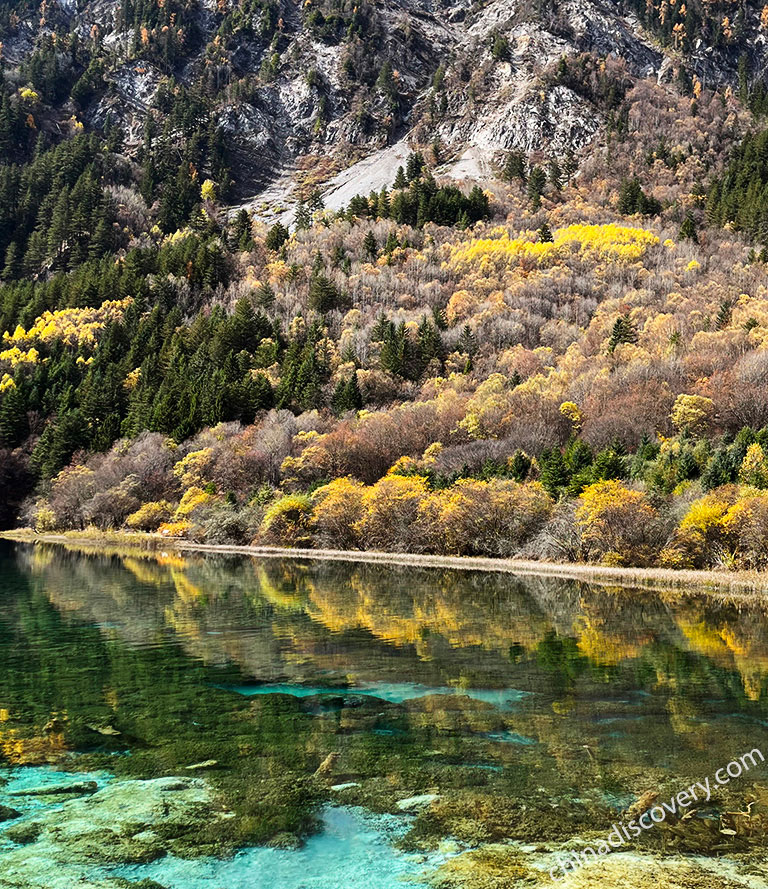
Five Flower Lake
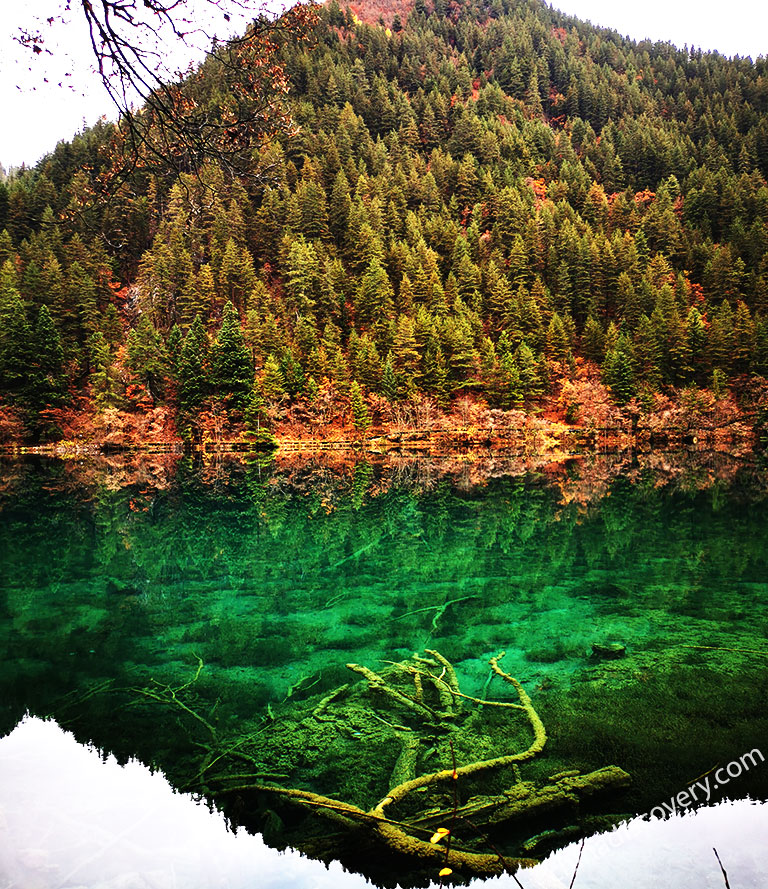
Mirror Lake
Recommended Visiting Route
With the Y shaped landscape, the Jiuzhaigou’s three main valleys are
distracted in three branches, centered on the intersection of Nuorilang.
Nearby the gate, Shuzheng Valley is the first/last to visit. For the
Zechawa Valley and Rize Valley, you need to backtrack to Nuorilang to
visit one after one. According to your time, you can plan your
Jiuzhaigou tour for one or two days. The more time you stay, the better
you will enjoy.
If you have one day
Take tourist bus from the gate to Nuorilang to view the
symbols of Jiuzhaigou. Then transfer to Zechawa Valley to visit the Long
Lake, Five-Color Pond and Seasonal Lakes. Later, go to the Rize Valley
to visit the Panda Lake, Five Flower Lake, Pearl Shoal and Mirror Lake.
Finally, you’ll transfer back to gate from Nuorilang, during the way,
you can view the Shuzheng Lakes including Tiger Lake and Rhinoceros
Lake.
This one day Jiuzhaigou Tour is a little bit rush and you
may visit a few of typical lakes.
If you have two days
Day One: in the morning, take tourist bus from gate to
Nuorilang, then transfer to the Long Lake spot of Zechawa Valley to
enjoy the biggest and deepest lake of Jiuzhaigou. Along the way back to
Nuorilang, you can appreciate the Five-Color Pond and Seasonal Lakes.
Then you may take a close look at Nuorilang Waterfall, where you have
lunch. In the afternoon, take bus directly to the gate and stop at each
spot of Shuzheng Valley, such as the Rhinoceros Lake, Sparking Lake,
Shuzheng Lakes and so on to finish your todays’ trip.
Day Two: Go straight to Rize Valley (transfer from
Nuorilang) and visit the Arrow Bamboo Lake, Panda Lake, Five Flower Lake
and Pearl Shoal. In the late afternoon, leaving Jiuzhaigou.
Jiuzhaigou Photography
Known for the stunning nature, Jiuzhaigou is definitely the
heaven of photographer. With the eye popping waterscape of various lakes
and waterfalls, the most scenic spots for photographing are Long Lake,
Five-Color Pond, Mirror Lake and Five Flower Lake.
With a viewing platform close to Long Lake and a sidewalk around Five Flower Lake, it is convenient for photographers finding an advanced point. As for the Mirror Lake’s surface lake scenery and the different colored Five-Color Pond attract thousands of visits to record their beauty through the lens.
Other than that, the Nuorilang Waterfall, great site to present the dynamic charm of Jiuzhaigou, is fascinating to photographers.
Best seasons to go: In Summer, the enough bright sunshine will contributed to take great photos; And Autumn is the best season to visit Jiuzhaigou, when the groves around the lakes are a depth of diverse tints and the landscape is covered with colored leaves.
With more Jiuzhaigou shooting sites & tips, read about Jiuzhaigou Photography Guide.
With a viewing platform close to Long Lake and a sidewalk around Five Flower Lake, it is convenient for photographers finding an advanced point. As for the Mirror Lake’s surface lake scenery and the different colored Five-Color Pond attract thousands of visits to record their beauty through the lens.
Other than that, the Nuorilang Waterfall, great site to present the dynamic charm of Jiuzhaigou, is fascinating to photographers.
Best seasons to go: In Summer, the enough bright sunshine will contributed to take great photos; And Autumn is the best season to visit Jiuzhaigou, when the groves around the lakes are a depth of diverse tints and the landscape is covered with colored leaves.
With more Jiuzhaigou shooting sites & tips, read about Jiuzhaigou Photography Guide.
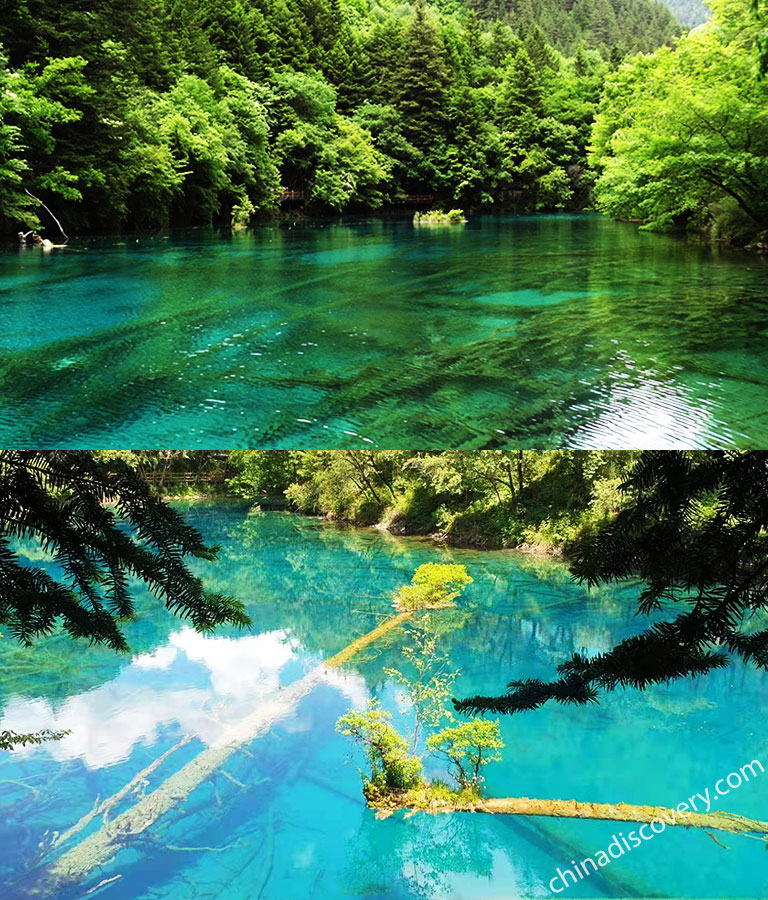
Jiuzhaigou crystal water
Nearby Attractions
Jiuzhaigou County, like a sequestered nature land, is full of
wonderful landscapes of tourist scenic spots. 144km away from
Jiuzhaigou Valley, the Huanglong National Park and Mounigou Valley are worth to visit.
Huanglong National Park: also called Huanglong Valley, the
Huanglong National Park is known for its magic landscape of lime
formations, and the multi-colored Terrace Ponds, especially the
Five-Color Ponds. Featuring the scenery for the limestone valley,
Huanglong is another tourist attraction together with Jiuzhaigou to
experience different landscapes of water land.
Mounigou Valley: located in the southwest side of Songpan
County, about 3 hours driving from Jiuzhaigou, Mounigou Valley features
the beautiful lakes, splendid calcified waterfalls, groups of Karst
caves and pearl hot springs. The main scenic spots of Zhaga Waterfall
and Er’daohai, including a series of lakes with crystal clear water and
the magnificent layered waterfall await you to visit.
Get to Jiuzhaigou from Chengdu
Chengdu to Jiuzhaigou by air (240 km air distance)
Getting to Jiuzhaigou from Chengdu by air is the fast way and
convenient for only 40 minutes, about over 20 flights available to
Chengdu Shuangliu International Airport.
Located between Jiuzhaigou and Huanglong scenic area, the
Jiuzhai-Huanglong Airport keeps distance from them for 88 km and 50 km
respectively.
(1) By flight from Chengdu, you can directly to Jiuzhaigou Valley (1.5 hours bus);
(2) Or you may visit Huanglong first (1 hour bus driving) and transfer to Jiuzhaigou Valley for another 2 hours.
Chengdu to Jiuzhaigou by bus (435 km land distance)
To save money, taking bus from Chengdu to Jiuzhaigou Valley
is a popular way for about 8-10 hours. During the long distance bus
trip, you can appreciate the authentic beauty of Tibetan villages and
the natural scenery to kill time.
With more detailed transportation, learn about How to get from Chengdu to Jiuzhaigou.
Travel Tips
(1) Altitude sickness
Jiuzhaigou is located in the high altitude and tourists
should notice your body condition to avoid the altitude stress, which
present symptoms of headache and palpitation, or ever worse.
(2) Tickets Notice
It’s a rule for most Chinese tourist sites to list two
charging standards for busy-season or off-season, Jiuzhaigou Valley is
no exceptional. Check the table below to find out the different charges
of the busy-season (April 1 to November 15) and the off-season (November
16 to March 31) in Jiuzhaigou:
| busy-season | off-season |
| ticket | 220 RMB | 80 RMB |
| tourist bus fare | 90 RMB | 80 RMB |
Note:
(a) The tourist bus fare is compulsory and only last for one day. The operate time is from7:00 to 17:00.
(b) Normally the ticket is last for one day, if one day is
not enough for you and want to get in on the next day to appreciate
thoroughly, you need to buy the ticket again when travel in busy-season;
or you may only pay extra 20 RMB during the off-season.
(3) Jiuzhaigou in Four Seasons
Visit Jiuzhaigou in different seasons, you can enjoy the
different sceneries. In Spring, you’ll encounter the ice melt water land
with everything is blossom; travel in Summer, you’ll immersed in the
furious lakes reflecting their sparks through the dazzling sunshine and
the tendering wind; as for the Autumn, Jiuzhaigou welcomes you with its
best colorful lakes and all tinged mountains; in Winter, the ice-covered
peaks, the frozen waterfall and the placid lake present you a sense of
tranquility.
(4) Where to live
Living in the Jiuzhaigou Valley is not comfortable with only
basic facilities and not allowed. Therefore, we recommend some hotels
nearby Jiuzhaigou Valley for you to stay in comfort and convenient for
you to get to Jiuzhaigou scenic spots, including Sheraton Jiuzhaigou
Resort, Jiuzhaigou Qianhe Hotel and Jiuzhaigou Xingyu Grand Hotel.
(5) What to pack
Comfortable shoes, sunglasses, appropriate dressing to avoid
the summer heat and cold winter are quite enough for you to have a
pleasant tour here. Besides, it is advisable to take some water and
snacks to appease hunger.
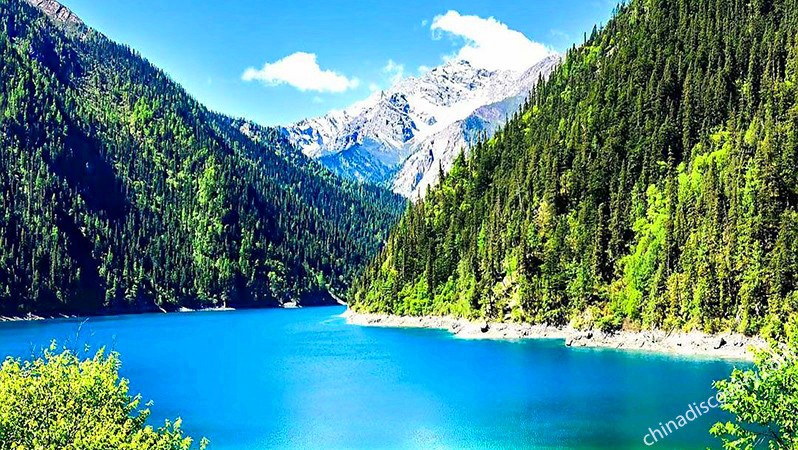
No comments:
Post a Comment